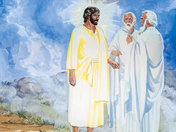Lesson 3: The image of the invisible God (series: Lessons on Colossians)
by John Lowe
(Woodruff, S.C.)

4/20/18
Tom Lowe
Lesson IIA1: The image of the invisible God (Colossians 1:15a)
Introduction:
This is the most important passage (Colossians 1:15-2:7) of the Colossian letter. But what prompted Paul to produce this “great Christology,” as it has been called? It was the heresya in Colossae. The hereticsa, by making Christ only one in a series of mediators strung out between our amazing God and the material world, had scaled down Christ and His work and robbed them of their unique importance. The issue was and still is, crucial. If Christ is to be truly the Savior of the world, the Christian must be sure not only that Christ is big enough for the task assigned Him, but that what He has done is all that is needed for the world’s redeeming. Paul is quite sure that, on these counts, Christ more than measures up, as we say.
a Heresy is any belief or theory that is strongly at variance with established beliefs or customs, in particular, the accepted beliefs of a church or religious organization. A heretic is a proponent of such claims or beliefs. Heresy is distinct from both apostasy, which is the explicit renunciation of one's religion, principles or cause, and blasphemy, which is an impious utterance or action concerning God or sacred things.
Lesson IIA1:
15a WHO IS THE IMAGE OF THE INVISIBLE GOD
God is an infinite and eternal Spirit, incomprehensible and invisible. “No man hath seen God at any time”; yet humanity yearns for some visible embodiment of Deity. Christ reflects and reveals the Father. “He is the brightness of His Glory, and the express image of His person.” Christ as the eternal Word is the perfect image, the visible representation, of the unseen God. In addition to the idea of similarity, which is capable of a wide and general use, the word “image” involves two other uses.
1. Representation—It implies a predecessor of which the image is a copy. Man is said to be made in the image of God; but there is a difference between the image of God in man and the image of God in Christ. In Christ it is like Caesar’s image in his son; in man, it is like Caesar’s image on his coin. In the God-man Christ Jesus, we have a visible, living, perfect, and reliable representation of the invisible God.
2. Manifestation—The general idea of the Logosa is the manifestation of the hidden. “No man hath seen God at any time; the only begotten Son, which is in the bosom of the Father, He hath declared Him” (John 1:18). The incarnate Word, in His nature, attributes, and actions, is the true epiphany of the unseen Deity, setting forth, like distinct rays of the one and the same glorious light, His infinite wisdom, mercy, righteousness, and power. Our obligations to Christ for His wondrous revelations are unspeakably great.
In verse 15 Paul is speaking of the Son, the author of redemption and forgiveness of sins. It is, therefore, Jesus Christ our Lord in His role as “Mediator” whom Paul characterizes as being “the image of God.” When He dwelt upon the earth, Jesus Himself said, “He that hath seen Me hath seen the Father.” The truth of that statement is simply this: Our only vision of God the Father is in His only begotten Son, the Lord Jesus Christ. “No man knoweth the Father but the Son, and He to whom the Son shall reveal Him.” All that we can ever know about God the Father is revealed to us through God the Son. CHRIST AS CREATOR AND SAVIOR IS THE IMAGE OF GOD.
As “Redeemer,” Jesus is the representative of God on earth. Paul said, “God was in Christ, reconciling the world unto Himself” (2 Corinthians 5:19). The prophetic name of Jesus was “Emmanuel, God with us.” Jesus in His incarnate state brought God near to us, when God placed Him on earth in a form that we could appreciate, understand, and know. Men saw Him, heard Him and handled Him. They saw in Jesus a weeping, suffering, loving God. Jesus was a living image—not a mystical being, not a spirit from another world—but God in flesh. Jesus while on earth held out to men an image of God in love. He displayed love as no other had ever displayed love on this earth. He was tender, self-denying, kind and long-suffering. No man ever lived or loved or sacrificed as Jesus did.
Those who knew Jesus best knew that He was more than a man; His wisdom, His holiness—everything about Him—testified to that fact. Through stormy weather, He came to His disciples—walking upon the waves. When the dead were recalled from the grave . . . when, touched with His tender hands, death gave way to life; those who witnessed it happen knew they were standing in the presence of divinity. When He rebuked the storm with “Peace! Be still!” the wind grew calm, the boisterous waves settled around the prow of the little ship—and the disciples knew they had heard the voice of God! They knew they were in the presence of Jehovah, who said, “I kill, and I make alive; I wound, and I heal” (Deuteronomy 32:39).
When five thousand hungry people watched Him break the loaves and fishes to feed the multitude (with much too spare), they knew the food they ate had been touched by hands that were more than the hands of men; the hands of God had broken the loaves and fishes.
His hands touched and healed the leper, thus disobeying all the laws of medicine and all the social laws of that day. His hands touched blinded eyes and gave them sight . . . the hands of Him who came to give men life abundantly. The wonderful words He uttered arrested the hearts of His enemies and in John 7:44-46, when the officers were asked why they did not bring Him, they simply answered, “Never man speak like this man!” His daily miracles testified to His divinity. Everything He did and said demonstrated divine omniscience and omnipotence.
I am talking about God’s only begotten Son . . . the Son of His love . . . the Son who walked on this earth, a visible image of the invisible God. Also, He was a revelation because He is the Equal of the Father—
I. In His nature.—The incarnation.
II. In his attributes.
III. In His will.—The character of Christ and His moral system.
IV. In His works.—His miracles, His death as a sacrifice for sin, His resurrection.
a. How ungrateful and unbelieving have we been!
b. How zealous and devoted should we be!
We understand from this lesson that when Paul calls Christ “the image of the invisible God,” he means that He is the visible manifestation of God.
a Logos is the Greek term translated as “word,” “speech,” “principle,” or “thought.” In Greek philosophy, it also referred to a universal, divine reason or the mind of God.
No content on preachology.com may be printed or
copied to any other site without permission.
|
The Preaching Ezine Subscribe to my free newsletter for monthly sermons and get a free book right now. Just follow the link above and get the details! |
|
Sermon Supply Ministry
Be ready for Sunday…before Saturday night! |
|
Manna Seminary
Did you ever want to start or finish your Ministry Training? |
|
YOUR PAGES: by sharing YOUR great sermons! by sharing YOUR great poems! |










